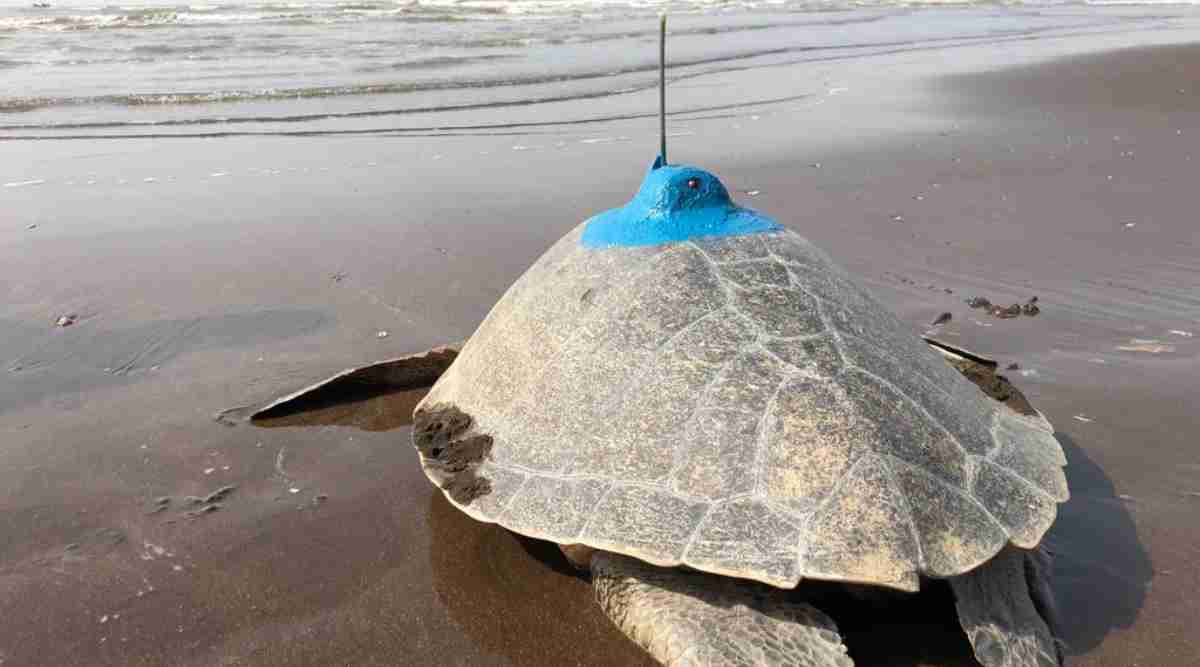 The other sea turtle 'Saavani', who was tagged and released from Anjarle beach, also in Ratnagiri district, continued to remain in the nearshore waters of the beach. (Express Photo)
The other sea turtle 'Saavani', who was tagged and released from Anjarle beach, also in Ratnagiri district, continued to remain in the nearshore waters of the beach. (Express Photo) Prathama, the first Olive Ridley sea turtle to be satellite tagged from the coast of Maharashtra, has travelled 75 kilometres south of Velas beach in Ratnagiri district.
Researchers from the Wildlife Institute of India (WII), Dehradun and the Mangrove Foundation, an autonomous body under the state government, tagged two female adult Olive Ridley turtles with a satellite device to monitor their path on January 25.
The other sea turtle ‘Saavani’, who was tagged and released from Anjarle beach, also in Ratnagiri district, continued to remain in the nearshore waters of the beach.
The two turtles were tagged with platform transmitter terminals (PTTs), which were fitted with epoxy resin on the carapace (hard shell) of the turtle. The transmitter weighs less than 3 per cent of the body weight of the adult turtle, which ranges between 40-45 kgs.
A total of five sea turtles will be tagged as a part of the study and the researchers will attempt the second leg of tagging this week.
Researchers monitoring the sea turtles movement said both turtles have remained in the nearshore/shallow waters in the last 17 days (till February 11). Prathama’s tracker showed that after being released from Velas it came almost near shore at Guhagar beach.
Dr R Suresh Kumar, senior scientist from the Department of Endangered Species Management, WII, Dehradun explaining the purpose behind the exercise said, “Olive Ridley population can be divided into two— mass and solitary nesting population. We are attempting to understand the migratory pattern of the solitary nesting turtles that are found along the Maharashtra coast during this time of the season. Where do these turtles migrate, what are the nearshore or offshore areas these turtles use? These are some of the queries.”
Kumar who has also studied turtles along the east coast hypothesised that the turtles are likely to remain in the nearshore or shallow water waiting for the ocean currents to begin their journeys into the deep sea further down to Lakshadweep or drift towards Oman, Somali coastline and return later this year in October-November to nearshore waters.
He believes that those currents will start to set in near the shore in March.
In 2001, the state forest department, along with the WII had fitted four turtles with PTTs, at Devi beach in Puri district. Its migration path revealed that one of the turtles had circled the waters and only one was seen migrating south towards Sri Lanka.
It is currently suspected that the sea turtles navigate to the Middle East and Pakistan after laying eggs in Maharashtra.
“This is the first time Olive Ridley Sea Turtles along the Maharashtra Coast are tagged and are being studied. Very little is known about sea turtles that nest along the state’s coastline. We don’t know if they come to shore multiple times to lay eggs or return to the same place every year. This study aims to bridge that data gap,”said Virendra Tiwari, additional principal conservator of forests, mangrove cell.
“The initial observation has shown that the turtles have not drifted far from their nesting sites. The data will also help us in our conservation efforts. An earlier study of the Olive Ridley that nested on Odisha beaches showed that these turtles went up to Sri Lanka and returned to Odisha Coast for nesting,” he added.
As opposed to the Olive Ridley’s found along the east coast and especially those who visit beaches in Odisha for nesting, the Olive Ridleys nesting along the Maharashtra coast are sporadic and a solitary nesting population.
The mass nest population remains in nearshore waters along the Odisha coast for at least 3-4 months.
Kumar added, “In the case of solitary nesting turtles, it is the decision of the individual turtle to nest, the time, the beach. There is no social signalling between the solitary turtles, unlike the mass nesters. For this reason, the solitary nesting turtles will behave very differently. How they use nearshore waters will be different. They would not be residents in these waters, that’s what I hypothesise. We don’t know as of now if they are resident or migratory.”
Olive Ridley turtles dig deep nests in sandy shores with their flippers to lay eggs and cover them up with sand.
While mass nesting is seen on beaches of Odisha, where lakhs of female turtles turn to the beach. In Maharashtra, nesting is recorded across three districts in the southernmost region of the state— Raigad, Ratnagiri and Sindhudurg and is sporadic.
Olive ridleys are globally distributed in the tropical regions of the South Atlantic, Pacific, and Indian Oceans. They are listed as vulnerable in the International Union for Conservation of Nature (IUCN) Red list and are also protected under the Wildlife Protection Act of 1972.
- The Indian Express website has been rated GREEN for its credibility and trustworthiness by Newsguard, a global service that rates news sources for their journalistic standards.

